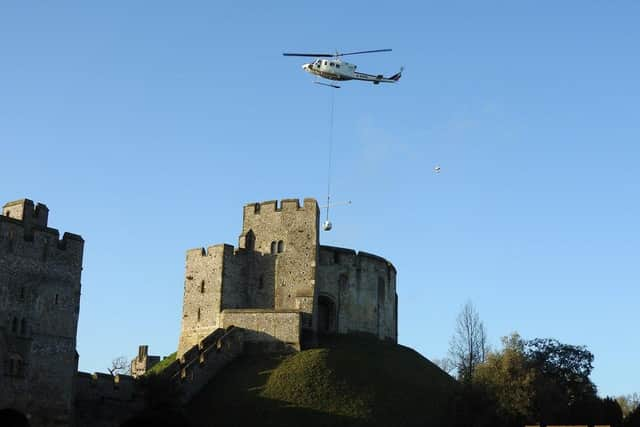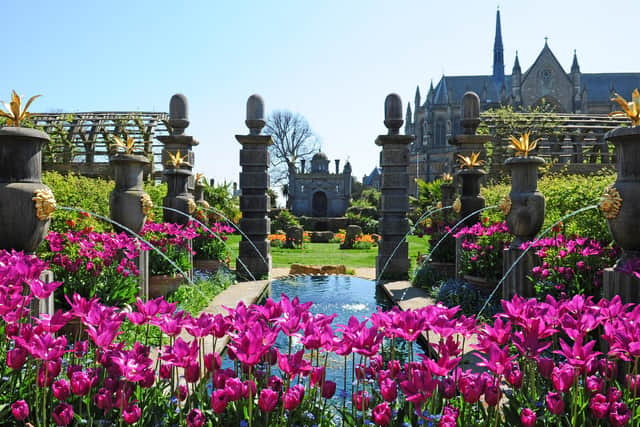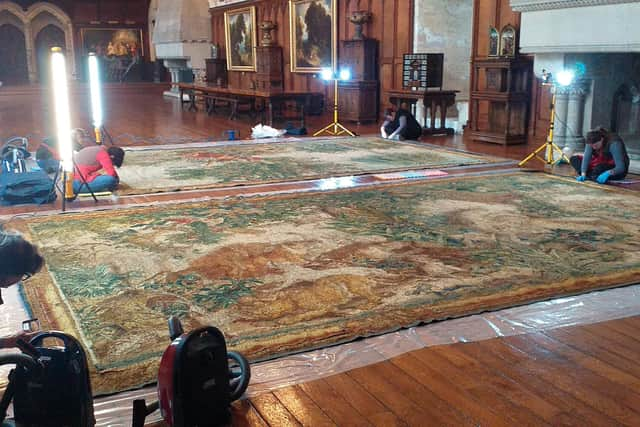Learn more about Arundel Castle's unbelievable spring clean


His cousin Roger De Montgomery obliged and, almost 1,000 years on, the castle, though restored and remodelled, still stands and welcomes almost 200,000 (friendly) visitors a year.
As they wander the myriad corridors adorned with priceless art and furniture, there are few clues to how it is kept in such pristine condition.
Advertisement
Hide AdAdvertisement
Hide AdBut once the final visitors of the season are waved off, the gates close and it is a hive of activity as the 32-strong team of staff set to work.


They must hand polish 27 gunmetal radiators, apply 50 tins of beeswax to shine up 300 square metres of oak panelling, and individually dust down each of the 10,000 library books, wind up 27 clocks and, in the gardens and grounds, plant tens of thousands of bulbs.
But those are just the small jobs.
Castle manager Stephen Manion, who has been in the post for two-and-a-half years, explains.
‘The Castle and gardens are part of the Arundel Castle Trust, which is independent from the rest of the estate. It was set up to preserve them for future generations to enjoy.


Advertisement
Hide AdAdvertisement
Hide Ad‘I have a fantastic team, they are very creative, hardworking and dedicated. The great thing is they are always thinking about how to improve the castle, the gardens and the experience of visitors.’
And part of those improvements mean taking on enormous challenges.
In a once-in-a-century conservation project, major works have taken place on the Norman Keep, and the restoration of 270-year-old tapestries has begun.
Parts of the keep at Arundel Castle date back to 1067. It is one of the finest examples of a Norman motte and bailey keep in England.


Advertisement
Hide AdAdvertisement
Hide AdThis year, helicopters were drafted in to remove more than 100 tonnes of spoil and soil from the keep and replace it with 90 tonnes of sand, Yorkstone and Purbeck setts to resurface the floor.
Mr Manion says the initial stages of the work on the keep were the most arduous.
Tons of sodden woodchip were removed by hand and transported through the ancient spiral staircases that were designed to keep warriors out.
When the helicopter arrived, it not only removed dirt and brought in stones, it also lifted in and removed a digger.


Advertisement
Hide AdAdvertisement
Hide AdStephen says: ‘The keep is my favourite part of the castle – it’s fantastic. It’s the original part of the castle, where it all started.‘When we take on conservation and restoration projects like resurfacing the keep, we’re not thinking about how it will look in weeks, months or years – we set out to preserve it for centuries.’
Conserving Arundel Castle’s tapestries is another gargantuan logistical task that requires dexterity and skill.
The Gobelin tapestries from the Nouvelles Indes series, dating back to 1750, usually hang in the Grand Staircase.
The pair, Le cheval rayé et Le combat d’animaux and Le Chasseur Indien, depict gothic scenes of indigenous flora and fauna of the Dutch colonies.
Advertisement
Hide AdAdvertisement
Hide AdNeeding a gentle wash and careful inspection, the huge tapestries needed to be taken down, a delicate task given their size, weight and fragility.
First, scaffolding was built from floor to ceiling of the soaring Grand Staircase.
The tapestries were then carefully removed and taken to a professional specialist textile conservationist company in Belgium to be cleaned.
They have been temporarily replaced by portraits of the 10th Duke and Duchess of Norfolk by celebrated painter John Opie.
Advertisement
Hide AdAdvertisement
Hide AdIt took a team of seven highly skilled art technicians to install the paintings in their temporary home.
‘There are no half measures in what we do’ says Stephen.
‘Our contractors are meticulous and ingenious in rising to the challenges of working in an ancient castle.
‘We have six-foot thick walls and solid stone floors here.’
While the scaffolding was in place on the staircase, the castle’s team couldn’t resist the chance to dust the life-size statues of St Henry and St Flora, dating back to 1890, at its very top.Using a vacuum cleaner, generations of dirt were removed. It may have been 50 or 100 years since the statues received a proper spring clean.
It’s a huge undertaking but, come spring, when the gates are – usually – opened to the public it is all worth it.
Advertisement
Hide AdAdvertisement
Hide AdStephen, says: ‘One of my favourite things is to wander round and overhear visitors talking about how much they enjoy it.
‘It gives you such a buzz.
‘In my job there is no such thing as a normal day, it is so varied. The telephone can ring and your work day changes completely, mostly for the better.
‘The heritage and history are what make it special – and knowing other people are enjoying it.’
Because of the coronavirus outbreak Arundel Castle’s spring opening has been delayed, along with the rest of the country’s tourist attractions.
Advertisement
Hide AdAdvertisement
Hide AdAnd that means the world-famous tulip festival – an explosion of colour in the castle gardens – is also on hold. But the flowers, which attract tens of thousands of visitors, should still be there come the summer thanks to the fantastic team of gardeners.
And there will be so much else to enjoy – all in pristine condition. ‘Our projects challenge our skills and abilities and pave the way for history to live on for the education and enjoyment of generations to come’, says Stephen.
Go to arundelcastle.org
One thousand years of history
Apart from the occasional reversion to the Crown, Arundel Castle has descended directly from 1138 to the present day.
It has been carried by female heiresses from the d'Albinis to the Fitzalans in the 13th century, and then from the Fitzalans to the Howards in the 16th century.
Advertisement
Hide AdAdvertisement
Hide AdArundel Castle has been the seat of the Dukes of Norfolk and their ancestors for more than 850 years.
From the 15th to the 17th centuries the Howards were at the forefront of English history, from the Wars of the Roses, through the Tudor period to the Civil War.
Arundel Castle was one of the first country homes to be fitted with electric light and central heating, thanks to the 15th Duke.
Edward Fitzalan-Howard is the 18th and current Duke of Norfolk.